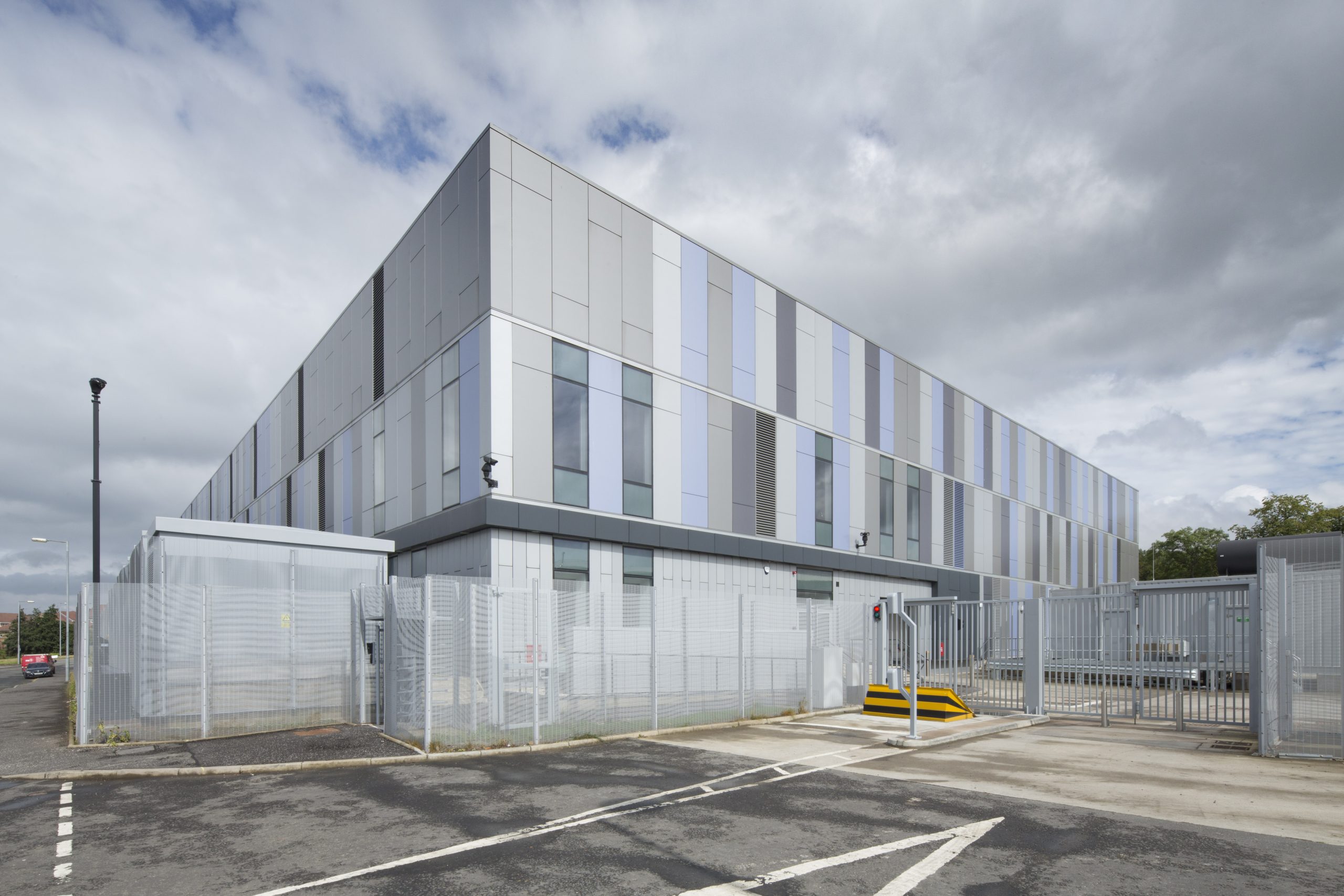Scalable Network Attached Solutions for Modern Infrastructure
Scalable Network Attached Solutions for Modern Infrastructure
Pure Storage ushers in an era of data storage with FlashBlade//E
Pure Storage has announced FlashBlade//E, a scale-out unstructured data repository built to handle data growth with energy efficiency. At an acquisition cost competitive with disk and much lower operational costs, the introduction of FlashBlade//E means that customers no longer need to settle for disk.
News highlights
FlashBlade//E provides a better way to manage unstructured data growth efficiently, reliably, and sustainably with a best-in-class user experience and economics that enable customers to eliminate the last remnants of disk in their data centre.
• Economical at scale: FlashBlade//E is offered at under $0.20 per GB including three years of service. The platform starts at 4PB and scales from there with reliable performance.
• Energy efficiency: FlashBlade//E consumes up to five times less power than the disk-based systems it will replace. The larger the system the greater the efficiency, helping organisations achieve their increasingly critical sustainability goals.
• Simplicity, reliability, and a non-disruptive future: FlashBlade//E is built to flex and grow on demand with 10-20 times more reliability than hard disk based systems and evolving without disruption or forklift upgrades. With cloud-like simplicity, flexibility and predictable performance, FlashBlade//E remains simple to manage at any scale.
FlashBlade//E will be generally available by the end of April 2023. In addition to traditional purchase, customers will have the option to deploy FlashBlade//E through a new service tier of Pure’s Evergreen//One Storage as-a-Service (STaaS) subscription, providing pay-as-you-go economics and a cloud experience with the control of on-premises deployment.
Industry significance
For global organisations, unstructured data capacity is expected to grow by 10 times before 2030. For large-capacity, price-sensitive workloads that use current disk-based storage solutions, this growth is unsustainable.
Disk-based systems are a burden on many enterprises’ IT teams and budgets as they are challenging to manage, require massive amounts of power, take up large amounts of space and their components fail too often, causing disruption and risking valuable data. Ultimately, this diminishes the ability to derive business value from data. While modern file and object storage solutions are capable of addressing many of these challenges, they haven’t been a viable option for large unstructured data repositories that are price-sensitive - until now.
Beatrice - 2 March 2023
Cyber Security Insights for Resilient Digital Defence
Data Centres
Scalable Network Attached Solutions for Modern Infrastructure
DCIG names the InfiniBox family one of the top five storage arrays
Infinidat has announced that DCIG has named its InfiniBox SSA II / InfiniBox one of the world’s top five high-end storage arrays. This ranking is based on independent research that DCIG conducted in the large enterprise market and among cloud service providers.
'The all-flash InfiniBox SSA II and hybrid InfiniBox arrays showcase Infinidat’s thorough understanding of enterprise high-end storage requirements,' according to the DCIG report. Among the product features that DCIG called out as exceptional in the InfiniBox platform is cyber resilience with InfiniSafe technology, which features near-instantaneous recovery, immutable snapshots, a fenced forensic network environment and remote logical air gapping for primary storage.
“Being named one of the top five high-end storage arrays clearly shows Infinidat’s attention to the business and technical values essential to large enterprise storage deployments,” says Eric Herzog, CMO at Infinidat. “This is the second consecutive year that DCIG has selected Infinidat in a top five list, which affirms the confidence that enterprise customers have in the Infinidat portfolio of cyber resilient storage solutions. We’re building on the momentum we gained in 2022 when DCIG named Infinidat as one of the top SaaS vendors. When large organisations need enterprise storage, Infinidat has the attention of their key decision-makers.”
“Large enterprises look to high-end storage arrays to provide a combination of high performance, high availability, cyber storage resilience, and comprehensive enterprise data services for all their business-critical data,” says Ken Clipperton, DCIG Lead Analyst for Storage. “The all-flash InfiniBox SSA II and hybrid InfiniBox arrays showcase Infinidat’s thorough understanding of these requirements, including guaranteed recoveries in less than one minute.”
The InfiniBox SSA II is the industry’s fastest all-flash storage array with an unprecedented 35 microseconds of latency. InfiniBox says that it provides unmatched high availability, comprehensive cyber storage resilience, ease of use, autonomous automation, and high reliability, plus comprehensive AIOps integration. Enterprise customers obtain optimal application and workload performance, simplify substantial storage consolidation, and reduce CAPEX and OPEX.
The InfiniBox and InfiniBox SSA II platforms for enterprise primary storage deployments are not only the most cyber resilient and most reliable storage solutions in the industry, but also the highest performing, according to Infinidat. Every InfiniBox and InfiniBox SSA II comes with a strong set of guaranteed SLAs: 100% availability guaranteed, performance guaranteed, and cyber resilience guaranteed. The solution delivers maximum performance with minimum administrative overhead.
The DCIG report also highlighted a number of appealing attributes of the InfiniBox platform, including:
• AI inside and outside the storage system with InfiniOps, which includes Neural Cache and the company’s data distribution and placement engine utilising machine learning to optimise data placement without tuning.
• InfiniVerse, which leverages InfiniMetrics telemetry for cloud-based monitoring, AI-based predictive analytics, and AIOps support software, enabling Infinidat support engineers to take preventative actions before the customer is impacted.
• InfiniBox Online Data Mobility, which enables non-disruptive workload movement between InfiniBox systems, ideal for organisations requiring more high-end storage than a single array provides.
• Flexible consumption and deployment models, leveraging storage-as-a-service (STaaS).
• Infinidat’s fully configured, rack-based approach, which facilitates rapid deployment at a customer location and instant capacity expansion.
Beatrice - 17 February 2023
Data Centre Operations: Optimising Infrastructure for Performance and Reliability
News in Cloud Computing & Data Storage
Scalable Network Attached Solutions for Modern Infrastructure
Centreon expands hosting capacity for its SaaS customers
Centreon has announced the opening of a new hosting region in North America for Centreon Cloud.
After Europe, North America becomes a second hosting region for Centreon Cloud, bringing the Centreon SaaS performance monitoring platform closer to international organisations looking to monitor their infrastructure, network, and digital experience performance. In addition to improving responsiveness, application performance, and resiliency for local customers, this new hosting region makes the Centreon Cloud platform fully available both in the US and in Europe, making it easier for international organisations to access SaaS monitoring, and quickly detect and fix critical issues on their IT infrastructure, networks, and applications.
This launch meets the accelerating demand from north American organisations for the Centreon Cloud SaaS monitoring platform, an efficient and cost-effective solution matching their needs for more innovation, performance and efficiency in running operations.
Julien Mathis, CEO and co-Founder of Centreon, says, “We are excited about our growth and increased focus in north America. With 15% of our community users residing there and a 50% ARR growth in 2022, this region is one of the most dynamic for Centreon. The Centreon team will continue to deploy more offers and high value-adding services in targeted regions to drive growth.”
Beatrice - 9 February 2023
Data Centre Operations: Optimising Infrastructure for Performance and Reliability
Enterprise Network Infrastructure: Design, Performance & Security
News
News in Cloud Computing & Data Storage
Scalable Network Attached Solutions for Modern Infrastructure
Spectra Logic partners with Wasabi Technologies
Spectra Logic has announced a partnership with Wasabi Technologies to integrate Wasabi cloud storage with the Spectra Vail unified data management solution. With the integration, Spectra Vail customers can now take advantage of Wasabi’s storage service, with no fees for egress or API requests, to further optimise data storage costs and accessibility across cloud and on-premises infrastructure.
By ensuring that data resides in the location where it brings the most value and at optimal cost, Vail enables organisations to extend their data centres, unifying on-premises storage with Wasabi hot cloud storage for a modern, scalable hybrid cloud architecture.
This announcement builds upon Spectra’s previous integration of Wasabi with Spectra StorCycle software for digital preservation. StorCycle is designed to archive and manage terabytes to petabytes of unstructured data without sacrificing data availability. Delivering policy-driven automation, StorCycle provides the flexibility to choose the most optimal tier of storage for data based on its frequency of access. The Spectra Vail and Wasabi integration takes this capability one step further by providing organisations managing data in a distributed workflow with universal access to data in a single namespace, and automated data placement across multiple clouds and sites.
“As enterprise data continues to grow, IT professionals are turning to cloud storage for the instant scalability and flexibility that the cloud offers. However, this raises the challenge of managing data between on-premises and cloud storage in an efficient, intuitive and cost-effective manner,” says Whit Jackson, Vice President, Technology Alliances and Media and Entertainment, Wasabi Technologies. “With Spectra Vail software, organisations can easily manage data from a single view across virtually any environment and move data in and out of Wasabi hot cloud storage without incurring ingress or egress fees, thereby enabling true storage cost optimisation.”
“With most industries experiencing massive data growth, many IT customers are planning ahead to accommodate future data expansion,” says Betsy Doughty, Vice President of Corporate Marketing, Spectra Logic. “Spectra Vail software in combination with Wasabi enables organisations to enhance their data centres by providing the ability to transfer data back and forth seamlessly to the most optimal storage tier, whether that be on-premises, in Wasabi’s cloud storage, or both.”
Beatrice - 2 February 2023
Cyber Security Insights for Resilient Digital Defence
Data Centre Security: Protecting Infrastructure from Physical and Cyber Threats
Data Centres
Enterprise Network Infrastructure: Design, Performance & Security
Scalable Network Attached Solutions for Modern Infrastructure
Vívaro Telecom teams up with MDC Data Centers in San Diego
MDC Data Centers has announced that its new data centre in San Diego will be ready to begin operations in Q2 of 2023. This new location is announced in partnership with Vívaro Telecom, a major Mexican network leader in telecommunications, media, IT solutions, and cyber security with more than 55 years of operations.
The new data centre will become the first of its kind in Southern California, and will provide redundant access to the company's fibre-crossing solutions that connect San Diego to the state of Baja California in Mexico with two independent routes, via Otay Mesa and via San Ysidro.
With a model proven in different markets, MDC San Diego enters into agreements with new founding members of the site to foster more interconnections to the border and bring better connectivity between the two countries.
A data centre built for its customers
During an annual customer appreciation event held in Mexico, Juan Salazar, CEO of MDC Data Centers, announced the beginning of physical and technical adaptations at the company's new facility in San Diego, California. Juan expressed his gratitude for the trust shown by MDC Data Centers' customers, and emphasised his commitment to turn MDC San Diego into a neutral interconnection point at the border.
Vívaro Telecom joins MDC San Diego as a founding member, highlighting the importance of the site in covering Baja California's need for interconnection and developing solutions that allow breaking the technological isolation of the state with the centre of Mexico.
"At Vívaro Telecom, we believe that this new facility is a reflection of MDC Data Centers' commitment to neutrality and customer-centricity. It will expand the company's unique business advocacy to a new strategic market, creating new business opportunities for all participants in the ecosystem," says Gustavo Mario De la Garza Flores, CEO of Vívaro.
San Diego is a hub for technology and innovation, but also a key element in MDC Data Centers' strategy to continue promoting its border platform. The new site will provide the infrastructure needed for its customers' growth in local and international markets.
Beatrice - 18 January 2023
Scalable Network Attached Solutions for Modern Infrastructure
Utilising digital transformation to provide time savings
Tendring District Council, based in Essex, have worked with Sophos and Espria for its IT security needs since 2014.
Business challenges
Several years ago, Tendring District Council implemented on-premise Sophos Endpoint Protection Advanced and was happy with the solution. More recently, the council has focussed on further digital transformation, moving all services and servers to a cloud environment.
With this in mind, and working with Espria, the council opted to transition to cloud-based Sophos Central. Completed in May 2020, Espria supported the organisation in working remotely with an ongoing priority for IT security after a minor ransomware incident caused the team to be highly aware of the prevalence of attacks in their sector.
The technical solution
The council moved to Sophos Central for cloud-based IT security for endpoints and servers with the added benefit of ransomware protection from Intercept X Advanced with EDR. The council also called in Sophos Professional Services to assist with the installation. Throughout the project, the team at the council used each step as a way of learning about the solutions, which included:
• Sophos Central: a unified console for managing Sophos products
• Intercept X Advanced for Server with EDR which protects virtual and physical servers without sacrificing performance, including one-click server lockdown
• Intercept X Advanced with EDR: a signatureless anti-exploit, anti-ransomware and root cause analysis tool that protects endpoints from advanced threats
• Professional services: consultation, implementation and configuration of solutions aligned with security needs and Sophos best practices.
Business benefits
Sam Wright is Cyber Security and Systems Manager at Tendring District Council. He lists the benefits of the Sophos/Espria partnership and moving to Sophos Central as being:
• Automation: the automation in Sophos Central when detecting and alerting potential threats eases the pressure on the IT team
• The interface: the team finds the Sophos Central interface very easy to use and issue-free, particularly when working remotely
• Threat analysis: Sam was impressed with the Sophos Endpoint Detection and Response (EDR) threat analysis in Intercept X Advanced with top threat indicators, live discovery and multiple categories and queries
• Behaviour analysis: intercept X Advanced examines the behaviour of attacks rather than definition - a different approach that provides heightened security
• Data security: device control within Sophos Central keeps data safe and the council compliant with GDPR
• Price: Sam believes he got a good deal from Sophos with customer-specific pricing
• Service: “The council is pleased with the service it has received from Sophos and Espria who are there to help whenever it’s needed.”
Sam is so pleased with Sophos’ services and the solutions provided that he has recommended them to his peers in the Essex Online Partnership - a collaboration of authorities including emergency services - and he also ran a demo for them.
“I’m always happy to recommend Sophos and Espria,” he says. “It’s easy to use, makes complete sense and empowers our technicians. Plus, Sophos is a well-established and trusted company that’s here for the long term. Sophos has definitely played a key role in our digital transformation project.
“Our technicians are very happy with Espria and Sophos Central. It makes it easy for them to drill down, review and investigate any issues that arise. It just makes sense, and it empowers our team.”
Beatrice - 14 December 2022
Scalable Network Attached Solutions for Modern Infrastructure
How to keep your IT running amid power uncertainty
Power outage…what next? It’s easy to take energy for granted. It helps keep us warm, safe, productive, clean, fulfilled, and healthy. However, the latest indicators show that Europe is now going into energy crisis mode. Disruption can negatively impact in many ways. For businesses that rely on critical IT equipment, the potential repercussions of power surges and outages can be devastating. For home and residential environments, the impact of power outages is not to be understated, especially as we approach the colder winter months. This blog article talks about how you can mitigate poor power quality and availability.
Read more here.
Carly Weller - 14 December 2022
Cyber Security Insights for Resilient Digital Defence
Data Centre Security: Protecting Infrastructure from Physical and Cyber Threats
Scalable Network Attached Solutions for Modern Infrastructure
Enterprise storage trends for 2023: vendors must rise to the challenge
By Eric Herzog, Chief Marketing Officer at Infinidat
Looking ahead, 2023 will be a very exciting year for enterprise storage, here are five trends we see emerging. In each case vendors will need to respond quickly with the right solutions, but do they have the right foundations in place to do so?
Convergence of cyber security and storage as a cornerstone of an enterprise IT strategy
CIOs and CISOs continue to increasingly realise that if they don't combine storage with cyber security, they're leaving a gap in their corporate cyber security strategy. IT leaders are accustomed to protecting the network and endpoints, deploying firewalls and looking at the application layer. However, all of their data ends up on storage. The great awakening in the enterprise market, heading into the new year, is that, if an enterprise storage solution does not have the capabilities to help combat a cyber attack, the C-suite and the IT team are leaving the organisation severely exposed. The trend emerging is for storage that is buoyed by cyber resilience to be part of the overall comprehensive cyber security strategy in every large organisation.
This means vendors must offer storage solutions that align with cyber security solutions and strategies commonly used to protect enterprises, as well as cloud hosting providers, managed hosting providers and managed service providers. It will require a vendor and its partners to work closely with CIOs and CISOs, along with other IT leaders and administrators, to make cyber-resilient storage a key part of a comprehensive cyber security strategy, plugging vulnerable gaps and securing the data against cyber attacks.
Boosting the ability to make a near-instantaneous recovery from a cyber attack with the highest level of trust in the data
The question is not 'if' your organisation is going to be hit with a cyber attack; it’s a question of 'when' and 'how often.' Your organisation will get attacked, and it could get attacked multiple times. At that point, it’s a matter of how you respond to that attack. Cyber resilience is among the most important and highly demanded requirements of enterprises today to combat cyber attacks across the entire storage estate and data infrastructure.
Even if your endpoint or your network security keeps the cyber criminals out once or twice, there will surely be times when they get through. When that happens, one of the critical things for an IT team is to get a known good copy of the data and make a speedy recovery. It's crucial to use an immutable snapshot of the data to ensure that the data has not been compromised. In other words, the data can be trusted. Finding a known good copy is done by curating the potential candidates to restore in a fenced forensic environment. The last thing you want to do is just start restoring data that has malware or ransomware infiltrated within it.
Vendors will need to offer solutions that combine immutable snapshots of data, a fenced forensic environment, logical air gapping, and virtually instantaneous data recovery - ideally with a rock-solid cyber storage guaranteed SLA. Once a cyber criminal gets through an enterprise’s line of defence, it’s all about resilience and recoverability of the data, building on a known good copy of the data. A cyber resilient storage infrastructure helps you more easily identify threats with automation and put data into a safe, fenced forensic environment. The cyber attack is nullified.
Harnessing the capability of anomalous pattern detection to do cyber scanning on secondary storage
We’re seeing a trend emerging more broadly in 2023 around cyber scanning with the ability to do anomalous pattern detection, particularly on secondary storage. In the longer term, we see an expansion onto primary storage over the next two to three years. This cyber scanning is another tool in the storage admin’s tool bag, along with cyber resilience, to be proactively strengthening the data infrastructure to handle the ever-increasing sophistication and deceptiveness of cyber attacks. Whether for money, power or perverse entertainment, these attacks are designed to take down your business.
Vendors will need to provide anomalous pattern detection capability, possibly through partnerships with backup vendors as part of a wider ecosystem. This is an evolving area of technology and it gives customers the ability to do scanning on secondary storage, adding further value for enterprise customers and partners.
Growing demand for ease of deploying cyber storage, resilience, and advanced security technologies
Enterprises and service providers are increasingly seeking easy-to-deploy and easy-to-use solutions that meet their needs for cyber storage resilience and integrated security technologies. They want not only automation, but also the next level up with autonomous automation. End-users don’t want complex set-ups anymore. They want to be able to quickly and efficiently access forensic environments, and when it comes to recovery of data, they expect two or three clicks, and then be done with it.
Vendors will need to respond with a ‘set-it-and-forget-it’ approach to cyber storage, offering advanced technology that is also easy to deploy and use.
Cyber resilience is being recognised as necessary for both primary and secondary storage as a safeguard against cyber attacks and internal threats
People often think that cyber storage resilience is only about backing up data. That’s not true. Cyber storage resilience is more than backup. This is an important distinction that speaks to a trend for the next year because smart cyber criminals won’t only attack your secondary datasets, like backup, but also attack your primary datasets. In recognition of this reality, enterprises and service providers are heading into the new year injecting new levels of cyber storage resilience into both their primary and secondary storage environments. There is a shift in the enterprise market starting to happen from being reactive - waiting for the cyber criminals to attack and then doing something about it - to proactively prepare for recovery, likened to disaster recovery. Companies usually have elaborate disaster recovery plans and business continuity measures. There is a growing awareness that 'cyber disaster plans' need to be put in place with the right set of capabilities to initiate and execute rapid recovery.
Vendors need to help customers rethink their approaches to cyber storage resilience, shifting approach reactive to proactive. Cyber storage resilience enables an enterprise to nullify a ransomware attack, as if the attack didn’t even happen. No ransom, no disruption and full protection against attacks.
Beatrice - 14 December 2022
News
Scalable Network Attached Solutions for Modern Infrastructure
South Lanarkshire Council cuts carbon emissions with IT upgrades
South Lanarkshire Council has transformed its digital and IT provision, resulting in significant carbon savings and helping to streamline the delivery of services to the local authority’s more than 300,000 residents.
Working with DataVita, the council will save over 2,000MWh of energy annually - down from 2,222MWh to 140MWh, a 94% reduction. Emissions will also be cut by 95% by migrating data storage to DataVita’s purpose-built DV1 facility.
Modernising its IT operations will enable the local authority to reduce the environmental impact of digital systems by tackling excess energy usage and wastage. Over the next five years, an estimated 12,800MWh of energy will be saved, equivalent to the amount of electricity used annually by over 400 average homes.
The IT transformation programme is designed around a new hybrid system, combining cloud based activities and data centre hosting at the DV1 facility in Chapelhall. The data centre uses 100% renewable electricity. It also uses energy efficient ‘free cooling’ technology, which utilises Scotland’s natural climate to maintain optimum temperatures, instead of air conditioning units.
Switching data centre locations will mean the local authority sees its power usage effectiveness (PUE) ratio improve substantially, from a rating of 2.3 to just 1.18. PUE is an industry benchmark for data centre energy performance that measures how much energy is used by the IT equipment, with 1:1 the optimum ratio.
Brian Teaz, Head of Information Technology at South Lanarkshire Council, says, “We have set ambitious targets including a 75% reduction in greenhouse gas emissions by 2030. Over the last six years we have already reduced that by more than 25%. There is still scope to do more, and this new IT approach is a good example of how modernisation can come with real environmental benefits.
“In recent years, as services have been digitised and moved online, our IT footprint has expanded quickly to give residents smarter and more flexible ways to access critical functions. The time was right to upgrade our digital infrastructure in line with new requirements and working with DataVita has enabled us to address sustainability at the same time, making significant carbon savings.”
The contract was awarded through the Scottish Government’s Cloud Services Framework, established in 2019 to support the government’s digital strategy. IT supplied through the framework includes public and private cloud, colocation, hybrid cloud, community cloud, and cloud transition activities.
Danny Quinn, Managing Director at DataVita, says, “Sustainability is high on the agenda for most organisations, but there is a common misconception that making changes either comes with a downgrade in terms of performance or substantial financial investment. Our recent experience with South Lanarkshire Council proves otherwise, and we have simultaneously upgraded the IT systems and reduced its carbon footprint. With the capability to deliver some of the most advanced technology currently available, our team has designed a flexible future-proofed system to cater for the council’s needs in the years to come.”
Beatrice - 30 November 2022
Data Centre Build News & Insights
Data Centre Projects: Infrastructure Builds, Innovations & Updates
Insights into Data Centre Investment & Market Growth
Scalable Network Attached Solutions for Modern Infrastructure
Marist College Canberra unlocks IT autonomy with Nutanix
Nutanix helped Marist College Canberra simplify its IT infrastructure and enhance the learning experience of its students and educators.
Established in 1968, Marist College Canberra is a Catholic school for boys from years four to 12. The school’s 200 teachers and staff provide a diversity of academic, spiritual, cultural, and personal development opportunities to its 1,800 students.
Sam Walton, ICT Systems and Operations manager, and his five-strong team are responsible for providing the IT infrastructure and rolling out new projects that keep students connected and continue to improve their learning experiences.
“From an IT perspective, schools are always a complex environment,” Sam says. “Not only are we a relatively large school with more than 2,000 end-users including students and teachers, but we also offer many extracurricular activities. The role of IT is to support all the different departments and all the applications they want to run in a single environment.”
Sam says that maintaining such a complex environment with legacy three-tier data centre architecture including servers, storage and networking - a system created decades ago - would be a resource-intensive challenge. A recent investment in Nutanix hyperconverged infrastructure, however, freed Walton and his team to deliver greater value to the school.
Sam adds, “Nutanix is the heart of our digital learning experience. We went from a full rack of SANs (storage area networks) and hosts which were much more complicated and required a lot more maintenance just to keep running, to Nutanix which is essentially ‘set up and forget’.
“In our IT team, we have to know so much about everything, so the really good thing about Nutanix is that it just works - I can’t be dedicating resources to maintaining the environment every week. The infrastructure we have now means my team can focus on more strategic projects for the college.”
Another benefit, according to Sam, has been the reduced hardware footprint which has in turn reduced the college’s energy consumption.
“IT infrastructure, particularly outdated infrastructure, can be a major energy burden,” he says. “Instead of a full rack, we’ve gone down to six RU (rack units) in our production environment. This has reduced power consumption to the point we’re now downsizing our UPS, which provides emergency power if the main power source fails.”
Marist is also using three Nutanix nodes for its on-campus Disaster Recovery (DR) environment which keeps systems going in the event of an outage, and another three nodes for object storage, which enables greater data scalability for the school.
“DR is now instant,” Sam says. “For example, late last year I had to move everything to the DR site and performance wasn’t impacted at all. No one noticed any difference. This has enabled me to sleep at night because I know now if something ever goes wrong, we can seamlessly switch over to DR.”
Jim Steed, Managing Director - ANZ at Nutanix, says Marist College Canberra has ensured the best learning experience for its students, both today and into the future.
“With its IT team liberated from having to keep the lights on, Walton and the Marist IT team can focus on the things that matter - like improving the student and educator experience - rather than putting out fires and constant maintenance. At Nutanix, we believe IT infrastructure should be invisible so organisations like Marist can focus on what they do best - educating the next generation of Australian leaders,” Jim concludes.
Beatrice - 29 November 2022

Head office & Accounts:
Suite 14, 6-8 Revenge Road, Lordswood
Kent ME5 8UD
T: +44 (0)1634 673163
F: +44 (0)1634 673173









